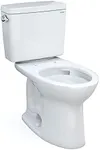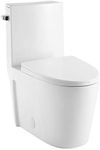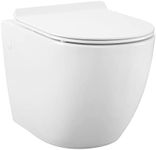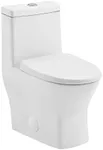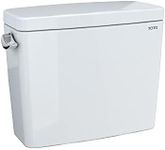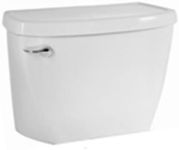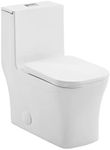Buying Guide for the Best toilets
Choosing the right toilet is more important than it might seem at first. A good toilet should be comfortable, efficient, easy to clean, and reliable for years to come. When shopping for a toilet, you’ll want to consider how it fits in your bathroom, how much water it uses, how easy it is to maintain, and how comfortable it is for everyone who will use it. Understanding the key features will help you make a choice that suits your needs and your space.Bowl ShapeThe bowl shape refers to whether the toilet bowl is round or elongated. Round bowls are more compact and fit better in smaller bathrooms, while elongated bowls are generally more comfortable for adults because they provide a larger seating area. If you have a small bathroom or need to save space, a round bowl might be best. If comfort is your top priority and you have enough room, an elongated bowl is usually preferred.
Toilet HeightToilet height is the distance from the floor to the top of the seat. Standard height toilets are lower and may be easier for children to use, while comfort or chair-height toilets are a bit taller and can be easier for adults, especially those with mobility issues, to sit down on and stand up from. Consider who will be using the toilet most often—if you have older adults or people with mobility challenges in your home, a taller toilet may be more comfortable.
Flush TypeFlush type describes how the toilet removes waste. The most common types are gravity-flush and pressure-assisted. Gravity-flush toilets use the weight of water to clear the bowl and are quieter and simpler to maintain. Pressure-assisted toilets use air pressure for a stronger flush, which can be more effective but are noisier and may require more maintenance. If you want a quiet, low-maintenance toilet, gravity-flush is a good choice. If you need extra flushing power, such as in a busy household, consider pressure-assisted.
Water UsageWater usage is measured in gallons per flush (GPF). Modern toilets typically use 1.6 GPF or less, with some high-efficiency models using as little as 1.28 GPF. Lower water usage saves money and is better for the environment, but you also want to make sure the toilet flushes effectively. If you want to conserve water, look for a toilet with a lower GPF, but check reviews to ensure it still performs well.
One-Piece vs. Two-Piece DesignToilets come in one-piece and two-piece designs. One-piece toilets have the tank and bowl fused together, making them easier to clean and often more stylish, but they can be heavier and more expensive. Two-piece toilets have a separate tank and bowl, which are easier to move and install, and are usually more affordable. If you want a sleek look and easy cleaning, consider a one-piece. If you prefer easier installation or need to carry the toilet up stairs, a two-piece may be better.
Rough-In SizeRough-in size is the distance from the wall behind the toilet to the center of the drainpipe. The most common rough-in size is 12 inches, but some bathrooms have 10 or 14 inches. It’s important to measure your existing toilet’s rough-in before buying a new one, as the wrong size won’t fit properly. Always check this measurement to ensure compatibility with your bathroom.
Ease of CleaningSome toilets have special coatings or designs that make them easier to clean, such as smooth sides or rimless bowls. These features help prevent dirt and bacteria from building up, making maintenance simpler. If you want to spend less time cleaning, look for toilets with these easy-clean features.
